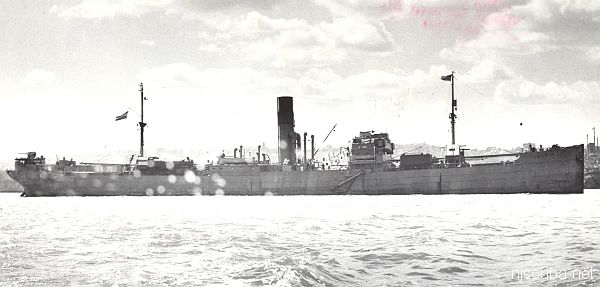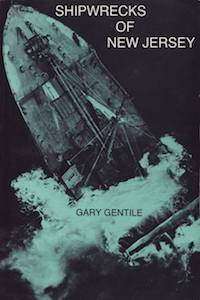Arundo (2/2)
Chapter 4: Arundo
reprinted from Shipwrecks of New Jersey
by Gary Gentile
| Built: | 1930 |
| Previous names: | Petersfield, Cromarty |
| Gross tonnage: | 5,163 |
| Dimensions: | 412' x 55' x 26' |
| Type of vessel: | Freighter |
| Power: | coal-fired steam |
| Builder: | Northumberland Shipbuilding Company, Newcastle, England |
| Owner: | N.V.Maats, Zeevaart |
| Port of registry: | Rotterdam, Holland |
| Sunk: | April 28, 1942 |
| Cause of sinking: | Torpedoed by U-136 ( Kapitanteutnant Zimmermann ) |
| Depth: | 130 feet |

Courtesy U.S. Coast Guard
By this time the war was in full swing, and military cargoes left New York on a regular basis. In this case, the materiel bound for Alexandria, Egypt, ( via Capetown, Africa ) was comprised of such delectables as 2,000 cases of evaporated milk, 7,000 cases of canned herring in tomato sauce, 4,500 drums of lubricating oil, 55,000 bags of nitrate of soda, 123 GMC 3-ton trucks, and, as deck load, two 2-8-2 coal-fired steam locomotives and their tenders. Oh, and 5,000 cases of beer.
Captain A.C. Trdelman, the Dutch master, had already lost one ship to enemy action when she was bombed in European waters. Everything seemed bright and cheery this spring morning: "the weather was clear, sea calm with slight swells, wind, little or none, visibility excellent." From the bridge, he saw two tankers and a U.S. destroyer 4 miles to the south, and 2 other merchantmen close to the horizon.
For a freighter and non-combatant, the Arundo was armed to the teeth: an aft-mounted 4-inch deck gun, two 20mm antiaircraft guns, two twin Marlins, and two 30 caliber Hotchkiss guns.
At 9:30 a.m., only 4 hours out of port, Chief Officer Akkerman and 3rd Officer Van Rhee spotted the wake of a torpedo. Instantly, a tremendous explosion tore out the starboard hull just under the bridge. The violent concussion shook the ship, and a column of water shot up into the air. "The hatch covers in #2 hold were blown off; #1 lifeboat destroyed, and the radio equipment damaged."
The submarine was not seen, and there was no time for the gunners to man their weapons. The Arundo took an immediate starboard list. It took only 5 minutes for the vessel to tilt to 90 degrees and slip beneath the waves.
The scrambling crew launched three lifeboats and two rafts. One of the lifeboats was pulled under as the ship sank, the other two were damaged. Most of the men ended up donning lifebelts and leaping into the frigid water. Of the crew of 43, 6 were lost: "Two individuals, a trimmer and a fireman, were not seen subsequent to the attack, and the other 4 men may have lost their lives either in the lifeboats that were faultily launched or because one of the locomotives, which were a part of the deck load, tipped into the water among the swimming survivors."
The men spent two hours floating about until the destroyer USS Lea picked them up. All the officers agreed that "the installation of a convoy system was necessary to protect merchant shipping along the East Coast of the United States."
No salvage was attempted. The wreck was marked with a buoy until it was demolished and cleared to a least depth of 63 feet. During a 1950 survey, it was again wire dragged, this time to 72 feet.
Because of its size, the Arundo is one of the most fascinating wrecks to explore: it is almost never-ending. Although the hull has been blown apart, huge sections remain intact. In several places, parts of the super-structure sit on slightly tilted angles, their rooms readily accessible but not complicated enough to be dangerous. Truck chassis are strewn about, as are axles and differentials; the metal bodies have long since rusted away. Rubber tires lie everywhere. Clear glass, 1-quart beer bottles abound by the thousands. Miscellaneous brass parts are all over the wreck.
The remains of the locomotives can be found in the sand on the starboard side, about 50 to 100 feet forward of the propeller. They lie on their sides and are difficult to recognize because the cabs are gone and all external metal components long since turned into rust. Essentially, what you can expect to see are just the long, narrow boilers, with the trains of wheels.
Interestingly, when John Dudas recovered the ship's bell, the name cast in bronze was Petersfield, the Arundo's christened name.
Fish practically blanket the wreck, and the convolutions of broken hull plates offer almost infinite hiding places for lobsters. Hardly anyone comes back from the wreck empty-handed; there is always something to bring up.
The U-136 survived only another couple of months. On her next war patrol, while operating off the west coast of Spain against a Gibraltar-bound convoy, she was sunk by the HMS Spey, the HMS Pelican, and the RF Leopard. There were no survivors.
GARY GENTILE'S POPULAR DIVE GUIDE SERIES
Shipwrecks of New Jersey

As suggested by the title and series name, this volume covers the most well-known wrecks sunk off the coast of New Jersey.
For each of the wrecks covered, a statistical sidebar provides basic information such as the dates of construction and loss, previous names ( if any ), tonnage and dimensions, builder and owner ( at time of loss ), port of registry, type of vessel and how propelled, cause of sinking, location ( loran coordinates if known ), and depth. In most cases, an historical photograph or illustration of the ship leads the text. Throughout the book is scattered a selection of color underwater photographs, some of the wrecks, more often of typical marine life found in the area.
Each volume is full of fascinating narratives of triumph and tragedy, of heroism and disgrace, of human nature at its best and its basest. These books are not about wood and steel, but about flesh and blood, for every shipwreck saga is a human story. Ships may founder, run aground, burn, collide with other vessels, or be torpedoed by a German U-boat. In every case, however, what is emphatically important is what happened to the people who became victims of casualty: how they survived, how they died.
Also included are descriptions of the wrecks as they appear on the bottom. At the end of each volume is a bibliography of suggested reading, and a list of more than 400 loran numbers of wrecks in and adjacent to the area covered.
To order this book and others like it, visit Gary Gentile's website at https://ggentile.com


Questions or Inquiries?
Just want to say Hello? Sign the .